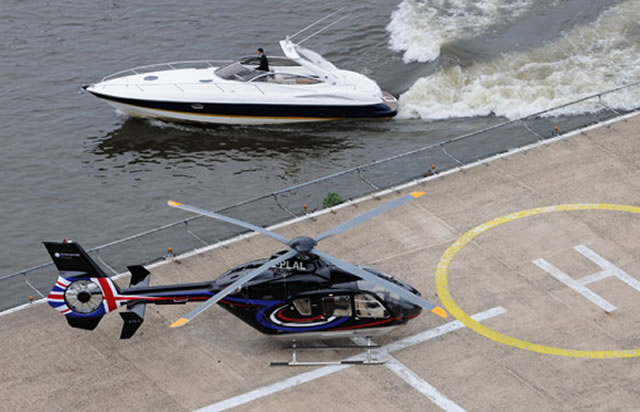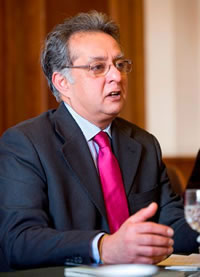Experts Conclude That Heliport Noise Could Be A Danger To Health
Councils, Mayor and London Assembly Member dispute who is responsible

The London Heliport
A recent report has shown that residents living in three riverside boroughs near the London Heliport in Battersea are being subjected to noise levels that could pose a risk to their health. The report from the ground-breaking study, the first of its kind in the UK that monitored noise levels near the heliport over a five month period last year.
Battersea Heliport opened on Lombard Road in 1959 and following closure of the City of London floating helipad it became and continues to be the only CAA licensed heliport serving the city of London.
The study, carried out by acoustics experts from London South Bank University, found that residents living close to the Thames in the boroughs of Wandsworth, Hammersmith & Fulham and Kensington & Chelsea are routinely subjected to noise disturbance that exceeds World Health Organisation (WHO) recommended limits.
The report’s findings have now sparked calls from all three boroughs for the heliport to do much more to limit the impact its operations have on neighbouring communities. And it’s prompted the leaders of the three boroughs to urge the Mayor, transport ministers and Civil Aviation Authority to work more closely with them in co-ordinated efforts to resolve the noise problems caused by the heliport.
The original consent was awarded by the now defunct Greater London Council (GLC) in the 1970s and means there is nothing that can be done to curtail the site’s operations under planning laws. The heliport’s planning permission allows it to operate within limits set on opening hours, a daily cap of 80 movements a day, and an annual limit of 12,000 movements. This allowance does not include emergency or military operations.
According to Wandsworth Council, part of the problem is the fact that the heliport has a historic planning permission allowing it to continue operating, even though it is in a densely populated part of London.
The authors of the report concluded that noise generated along the heliport landing and take-off flight path are at levels that could cause medium risk of adverse health effects on affected residents due to long term noise exposure.
The report lists a number of recommendations going forward, including attention being given to new planning applications and the inclusion of any balconies in future residential developments. This would ensure that noise impacts from the heliport are assessed in line with national planning guidelines.
It also points out that Defra had previously advised the Battersea Heliport Consultative Group that there was no statutory requirement for London Heliport to prepare a Noise Action Plan (NAP) because of insufficient data on helicopter noise performance. NAPs are designed to manage noise issues and effects arising from aircraft departing from and arriving from specific airports. The report concludes that the results of this study may now provide the
opportunity to develop a UK model for a heliport NAP.

Leader of Wandsworth Council, Councillor Ravi Govindia, said: “This study is the first evidence of the impact the heliport is having on residents living along the Thames. The conclusions, that the noise levels being generated are likely to impact on people’s health, are very concerning. This affects residents living across three boroughs and the study shows that, despite the introduction of a new, less noisy, helicopter fleet at Battersea, there are now hundreds, if not thousands of residents, regularly being impacted by noise at or above the operating threshold.
“All three councils – Wandsworth, Hammersmith & Fulham, and Kensington & Chelsea – now need to see some action in response to these worrying statistics. In the first instance we would call upon the Mayor, the Civil Aviation Authority and the Government to work together with us to find a more sustainable solution.
“Under the Mayor’s current Draft London Plan it is proposed that any new heliports are refused. We do not believe that is fair as it means that our residents are having to bear the brunt of having the flight path from London’s only heliport going over their heads.
“It is obvious that relocation of the Battersea Heliport is the only right solution but the Mayor’s draft London Plan has failed to grasp the nettle but there is still time for him to change his mind.
“He added: “In the meantime we call on the Heliport operator to do more to curb its impact and also work with us to improve this situation.”

London Assembly Member, Merton & Wandsworth, Leonie Cooper, pictured above, believes that the responsibility for the number of flights and the subsequent noise, lies firmly with Wandsworth Council: "Wandsworth Council has granted the Heliport consent to allow up to 12,000 flights per annum. As far as I understand it, this was something they were entitled to do under their own authority. The heliport as yet has never had this many flights, although the number is gradually increasing, with a passenger peak in the morning especially, and with the heliport encouraging more of the 5 and 10 minute joy rides up and down the river.
"Since the heliport was granted the 12,000 flight limit the Council has subsequently granted Planning Permission to an ever-increasing number of blocks of flats, in increasing proximity to the heliport. I’ve visited residents in some of these blocks and the noise is very loud as helicopters land and take off.
However, given that it is Wandsworth Council that has allowed both the 12,000 flights and granted the Planning Permission to developers to construct the nearby buildings, it’s hard to see why the Mayor should support a heliport elsewhere in London, bringing the same noise nuisance and air pollution to other Londoners.
Leonie finished by calling on developers to protect their residents: "My view is that it’s up to the Council and its Heliport Consultative Group to tackle the issue of the number of flights - 12,000 flights is equivalent to 33 flights a day, which would be an unbelievable noise nuisance and massively polluting, way beyond what is experienced now, but permissible. In a residential area, flights should be limited to a much lower number, with a cap on the joy riding too. In addition, developers building near to the heliport should be required to install triple or quadruple glazing as an absolute minimum, to ensure residents are disturbed as little as possible."
Councillor David Lindsay, Lead Member for Healthy City Living in Kensington and Chelsea, said: “A number residents have been in touch with me and my colleagues to complain about the noise from Battersea Heliport and I am absolutely sure councillors in Wandsworth and Hammersmith & Fulham have had to deal with the same issues.
“This report highlights some vital issues concerning the disturbance from the heliport and it’s time for the Mayor of London, Civil Aviation Authority and Government to take our concerns seriously and work to significantly reduce the blight on the lives of our residents.
“We will do all we can to support our residents in their demand to be able to enjoy their lives without continuous interruption.”
Councillor Wesley Harcourt, Cabinet Member for Environment at Hammersmith & Fulham Council said: “The results of this study confirm what residents across the borough have long been telling us – this heliport is a blight on their lives.
“It leaves us little choice but to lobby for stricter regulations on noise levels and volume of flights, so that we can better protect our residents’ standards of living.”
Dr Stephen Dance, Course Director for Environmental and Architectural Acoustics at London South Bank University (LSBU), who oversaw the acoustics research for this project, said: “London has only one commercial heliport, based at Battersea and built in 1959, since when the urban landscape has altered dramatically. The result is that this vertical gateway to London is now surrounded by housing which presents us with a noise management challenge.”
London Heliport & The Mayor of London have both been asked to comment.
August 9, 2018